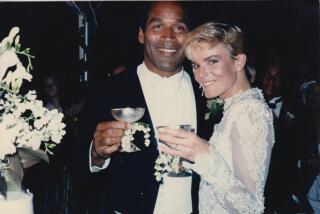THE O.J. SIMPSON MURDER TRIAL
- Share via
UCLA law professor Peter Arenella and Loyola University law professor Laurie Levenson offer their take on the Simpson trial. Joining them is Santa Monica defense lawyer Paul A. Mones, who will rotate with other experts as the case moves forward. Today’s topic: defense lawyer Barry Scheck’s cross-examination of LAPD criminalist Dennis Fung.
PETER ARENELLA
On the prosecution: A motive to kill and the opportunity to do so mean nothing if the jury entertains a reasonable doubt concerning the integrity and reliability of the physical evidence tying Simpson to the murders. At this juncture, the prosecution should be concerned that its ‘mountain’ of evidence is beginning to crumble with each reluctant concession by their criminalist that mistakes were made in how the evidence was collected.
On the defense: Having undermined Fung’s credibility, Scheck effectively attacked his competence. His questions highlighted mistakes made by Fung and others during the investigation. Among the noteworthy gaffes: Fung failed to secure O.J.’s Bronco as part of the Rockingham crime scene and an investigator used a blanket from Nicole Simpson’s condo to cover her, thereby risking the transfer of innocent hair or fiber traces left by O.J. on the blanket to the Bundy crime scene.
LAURIE LEVENSON
On the prosecution: The prosecutors’ best news of the day was that an alternate juror who once described DNA evidence as 100% reliable replaced a juror the defense wanted to keep. But then Fung had to spend the day deflecting Scheck’s questions regarding possible evidence contamination. Not only did Fung have to defend his actions, but he also had to second-guess ‘possible’ mistakes by LAPD and coroner’s officials who arrived at the scene before him.
On the defense: As anticipated, the defense began to develop its contamination theory in an effort to explain why Simpson’s hair was found at the crime scene. Using several hypothetical questions, Scheck pushed Fung to admit that such trace evidence could have come from a blanket placed on Nicole’s body. Because the blanket theory can only cover so much, Scheck suggested that airborne blood evidence also contaminated the crime scene.
PAUL MONES
On the prosecution: It could have been a mistake to have a novice do the crime scene collection. But in the final analysis that may be irrelevant. There is not a one-to-one relationship between the possibility of contamination and actual contamination. It’s not simply ‘garbage in, garbage out’ as some have asserted. The effectiveness of the defense argument would be better if there were one or two blood stains. If you have a match on several items, it’s harder to challenge.
On the defense: Scheck did a classic cross-examination. As well-crafted as the cross was, that doesn’t mean the crime scene samples were in fact contaminated. The ultimate serological and DNA tests provide a check for any contamination on the scene. If we follow Scheck’s logic, one would conclude that there was a secondary transfer of Simpson’s saliva and hairs to the crime scene. But the jurors may want proof that O.J. used the blanket.
Compiled by HENRY WEINSTEIN / Los Angeles Times
More to Read
Sign up for Essential California
The most important California stories and recommendations in your inbox every morning.
You may occasionally receive promotional content from the Los Angeles Times.












